John’s on my case, again. “Neal, you’ve gotta write the book on DIY solar power!” He gets this way, sometimes.
It starts with flattery. Continues with pleading. Sometimes he promises, “I’LL PAY YOU, I’LL PAY YOU!” If you know John, the phrase, “I’LL PAY YOU, I’LL PAY YOU!” is usually only uttered when he is running from a knife-wielding cabbie he’s stiffed. Honest! That’s a story best told by John, himself.
I have written books and have 4 in the works, now. I just don’t have the time to concentrate on all the stuff that happens AFTER the writing. One of the books is about my epic 44 day trip aboard the Sun King, solar-powered launch back in 2015. It is cleverly titled, “44 Days in the Sun.” Maybe I could share a chapter or two, since there is some useful info on solar power in it.
My first few books, history books, were written 2 pages at a time, I like to say. I did a weekly newspaper column back in the 90s and early part of this century. I compiled those pages and a few photos into books. So, if John asks, I’m writing his solar book a page or two at a time with this blog, OK?
There is no way you could write a book to cover all cases for solar power, at least not a book small enough to carry or cheap enough to afford. I think it would have to be a series of books in various niches. The basics are pretty simple. It is the details that get you all tangled up.
In a way, though, the book has already been written. I was reminded of this recently when I was called upon to recommission a system I took down a while back.
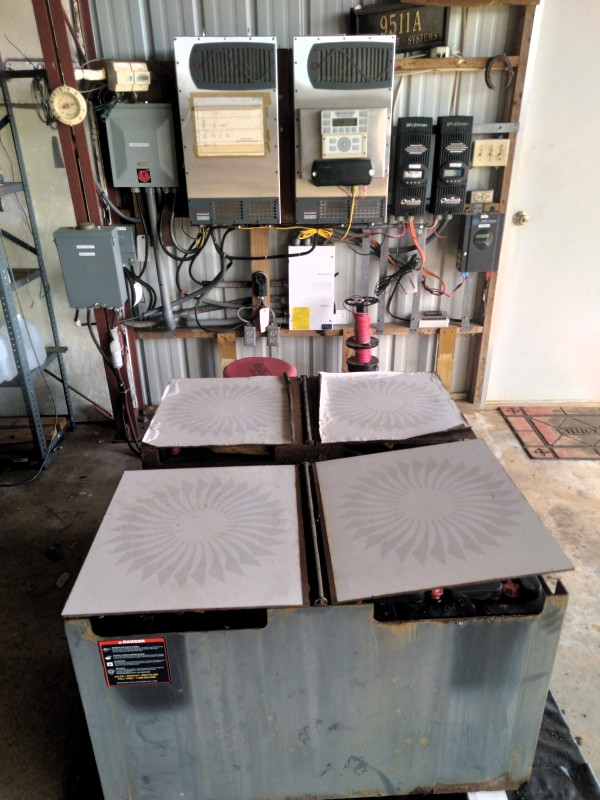
Some time ago I told you about shutting down Tom’s system. It was not working. Tom was dead. Jane was trying to get the house ready to sell. She didn’t want the unauthorized solar power system to be an issue with inspectors.
Now, Cory has the place and wants the solar power to work. I suggested he budget $20,000 for batteries if he really wanted to do it right. When he regained consciousness, he avoided me for months. Some time later, I came across a battery deal that was too good to pass up. It was him or me and I let him have it. $1000 for 1020ah of second hand forklift batteries from a mobile solar power system. Plus postage and handling. (No, they are not the Edison forever batteries) The seller said they were checked out and good. This remains to be seen, but they are worth the thousand in scrap value if they don’t work out. Cory and a buddy made a made dash to South Florida to fetch them and that was the last I heard for months. It isn’t good to let batteries sit for months without attention.
By the way, it happens that 1000ah is a good starting place for a home system, though a little small for the 10kw solar input of this system. Tom had started with 400ah and added 200 ah, later, repeatedly cooking them. New, the big batteries would be about 5 grand each. 4 of them would be nice….and 20 grand.
Then came the call. I made suggestions as to placement of the batteries and carefully avoided being there when the move occurred. They weigh 2000 lbs. EACH. He ended up with a sheet of foam on the floor, a sheet of black poly plastic and painted 2×4 rests on top of that. You don’t want batteries on a bare concrete floor for two reasons. A cold floor will cause stratification of the electrolyte and spilled acid–it happens–will dissolve the floor.
Connection was pretty easy. I converted the cable that came with the batteries by chopping off the Anderson forklift plug and installing some substantial ring terminals. I had the crimper with me and used Cory’s torch to solder the lugs for insurance and then shrink down the red and black shrink tubing to make it neat and pretty. When I took down the old system, I hung paper tags identifying stuff, like the battery cables. I removed the hodgepodge of cables and a bunch of shunts that Tom had installed to monitor pretty much everything that could happen. TMI, I say. Too Much Information and too much crap to confuse things. That stuff got ripped out. New cables installed, it was time to smoke test it.
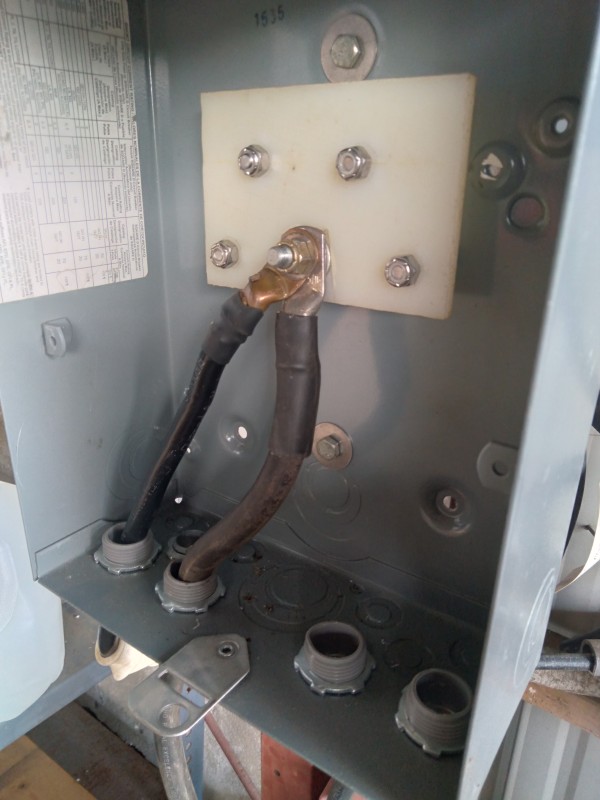
I waited until Cory got back from the Piggly Wiggly with 10 gallons of distilled water. The battery seller had claimed he topped them up, but we added 7.5 gallons if that tells you anything about the seller. OK, maybe there was some evaporation. It happens. When Cory returned, I had him start pouring.
Let’s have a little educational chat, here. Always use distilled water because it does not contain minerals that might interfere with the life and operation of the battery. The stuff costs a buck a gallon at the grocery or Walmart. It is absolutely imperative to keep the water/acid electrolyte above the plates, otherwise bad things happen. It is also imperative to not overfill the battery, as that can go badly, too. There is a split plastic ring down the hole. Better said, the fill tube extends into the cell, but is notched. Your target is to have the acid mix (you are pouring in water, but there is acid in there, which is not good for you) come up to the bottom of the split ring. That is for an active battery. These were cold dead batteries. Cory started out on the low side of filling and got better as he went along, or at least the cells got more full.
All watered up, it was time to throw the switch and see what happens. Main battery switch on, inverter pair and charge controllers light up. Combiner boxes switched on, solar inputs switched on and the current starts to flow. Lots of it. The panels are filthy and set at the wrong angle, but there are lots of them and the system came to life.
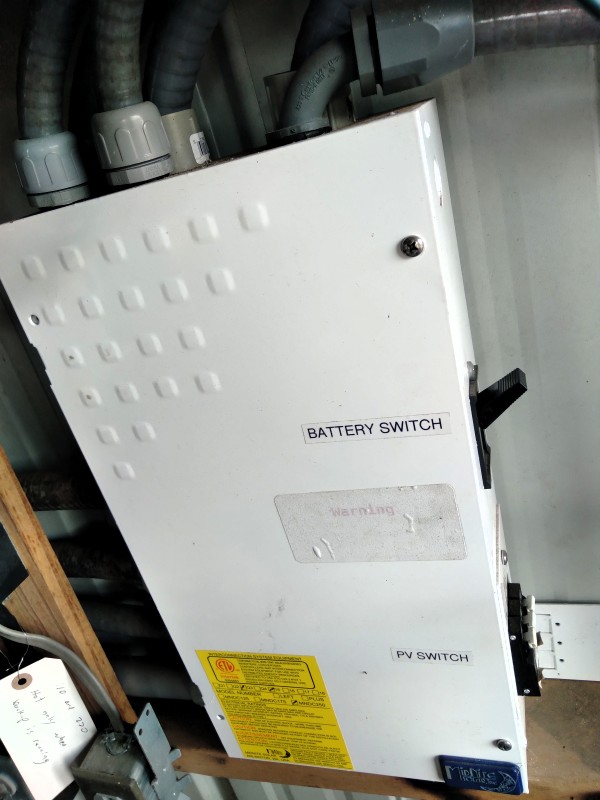
One of the batteries started bubbling vigorously. It was taking a charge. The other, not so much. The voltage came up quickly, so I got into the FlexMax 80 charge controllers and set up a 6 hour equalization. I am familiar with the FlexMax and even remembered the password (shhh 141) so I did not have to get into the documentation pack that had been left atop the inverters. The bubbly battery quickly warmed up just a little and all that electrolyte was expanding. Some was overflowing. We loosened the caps to all the cells to give them a little more breathing room. It wasn’t enough for some of them. See why we isolated the floor from potential acid spills?
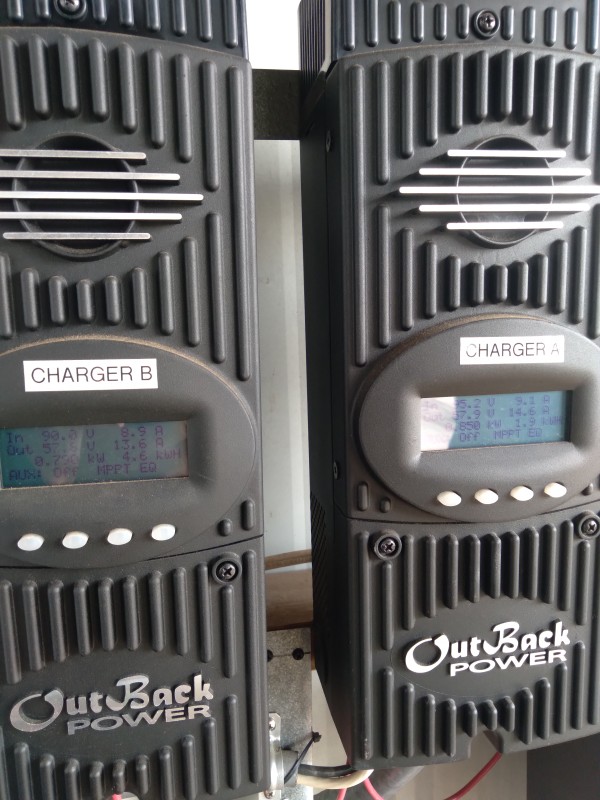
I gave Cory another chore. Obtain a new hydrometer and a notebook, then sample all of the cells. Next morning when I arrived he had his notebook and was just about to begin the sampling. The one battery was bubbling away and the other was giving only the occasional bubble. The hydrometer was not working so well. Cory had overlooked the fact that the maker had stuffed a strip of foam inside to keep things from rattling about and breaking during shipping. It worked better then. I commented that these tools are made of glass and are fragile, just before something fell and broke it. We sampled with another. One battery was in the high red zone. The other would not even float the bulb. This is going to take some effort. At least the cells were consistent within each battery.
Now, while Cory was taking and recording samples, I was trying to fine tune the inverters as I remembered something Tom had said about his setup and thought that we could get a little more out of it. In this case, I was in new territory with the Outback Radian GS8048 inverter and the Mate 3 monitoring interface. I needed to read the book.
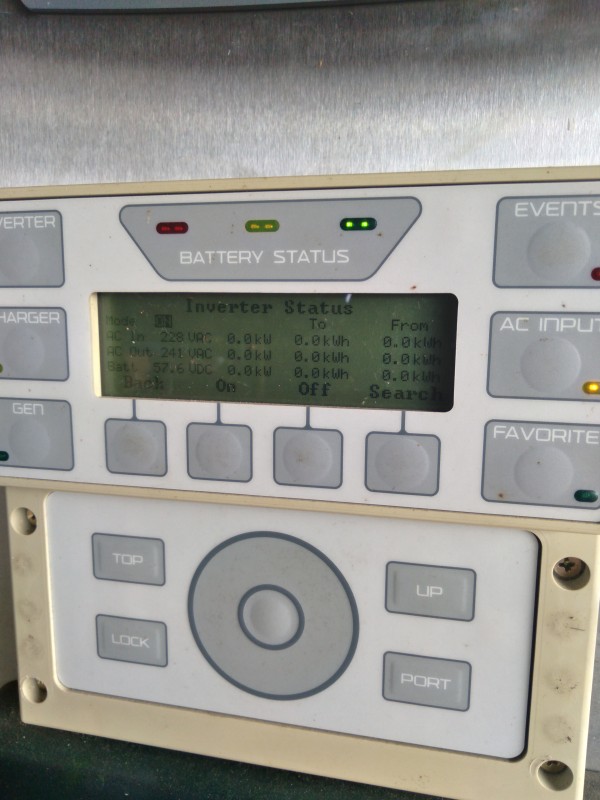
Boy what a book, since we are talking about books! There is a lovely poster that graphically shows all the connections you need to put together a system using Outback products and it really was all you would need to put your own system together. Programmable stuff always freaks me out a little, because it requires thinking and care. There are even different trains of menus, setting up the system in different ways.
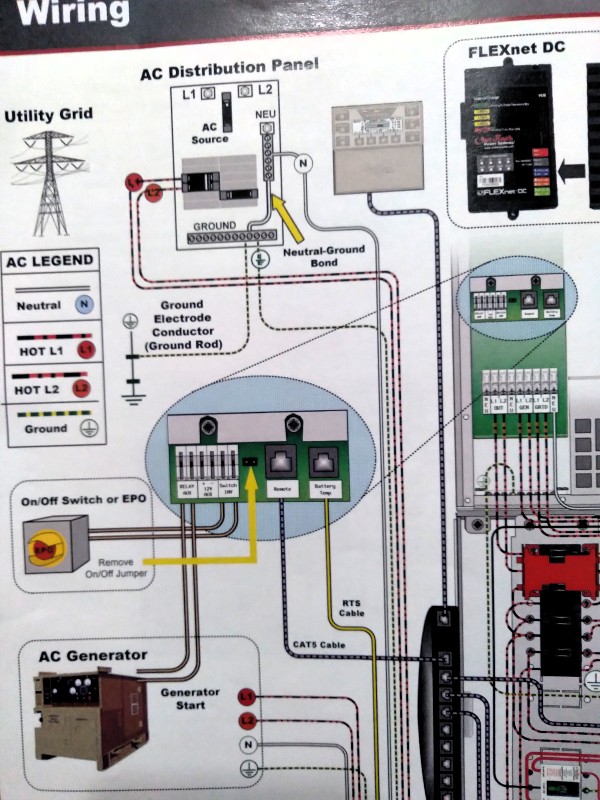
One thing stumped me, possibly because I didn’t have all the documentation, even though I think I did. I did not see a good discussion of the 3 operating modes and why you’d want to use one or the other. I chose BACKUP mode. The other thing I did not see was how to get into those lovely menus and how to change things. So I just started pushing buttons until I found the entry menu. First thing it asks for was the password. What? There was nothing in the notes about a password. 141 might have worked. 1723, I think, did work. Whatever it was, I wrote it prominently on the manual.
The really baffling thing was how to enter the passwords and other choices into the system. Thank you, “OK Google.” If you look at the Mate, there are not a lot of buttons or a keypad. That “target” area in the center is like a racetrack. Run your finger around it clockwise or the other way to make the numbers go up and down. The bullseye is the ENTER button. Simple, once you know.
Everything is running, but we have yet to throw the switch at the house. We are giving it as many days as it takes to bring the batteries up to full power (we hope). All went reasonably well and a big help in setting up a strange system was having The Book. The book that came with the hardware. The manual. The hardware always comes with a book. Some books are better than others, but usually they are very useful. Read The Book and learn.
I’ll have more about the system rebirth, soon. It is a work in progress.
–Neal

It’s fantastic, I loved reading it. I can’t wait for the next episode! I hope it’s about the problem with the utility companies and your suggestions on how to beat their system of “screw them all and have a ball”.